

 |
 |
It seems like my life over the last few months has been entirely emerged into the world of photography and time lapse work. I had been taking advantage of every clear dark and moonlit night to shoot the sky and soon had added a serious amount of hours under my belt at all hours of the night watching the heavens and keeping my photography skills sharp. It also happened that during this busy period of time lapse shooting with Dungannon photographer John Fagan that the universe woke from its slumber and began to produce a series of dramatic transient events in the form of aurora displays, meteor showers and thunderstorms, in short, the weather and the universe had begun to stir so I wasted no time in documenting these events. I have done so many nights during this Autumn period and took so many images that I couldn't possibly post them all on this report however I have decided that this would instead feature the highlight events and my favourite memories.
The first of two interesting meteor showers announced itself in dramatic fashion during the first two weeks of November in the form of the Taurid meteor shower - one of my personal favourites - the meteoroids from this shower originate from comet 2P/Encke which is the comet with the shortest period on record, it orbits the sun every 3 and 1/3 years with the radiant located within Taurus the Celestial Bull, this radiant can be found not far below the Pleiades cluster. The 'Taurid Meteoroid Complex' has a long peak and is not well know for high ZHRs however during 'swarm years' this stream can make a closer approach to Earth than usual with the result that our planet plows through a more dense portion of the meteoroid stream where larger dust particle encounters can ablate in our atmosphere resulting in spectacular fireballs. During previous swarm encounters I have witnessed numerous fireballs and even heard audio effects from a blazing amber fireball which lit up the sky above my neighbour's house back in 2005 accompanied by the sound of a 'sizzling frying pan'. I love this shower not just because of the fireballs but also because the Taurids have a role to play in the near impact hazard, in fact, some evidence suggests that the devastating Tunguska air burst detonation which flattened hundreds of miles of forest in Siberia during 1908 was in fact a fragment of comet 2P/Encke.
Add to this fact that I am also fond of Encke for personal reasons, during each return I have tracked it down in my telescopes however my first encounter with it during August 29th 2000 was one I will never forget, before dawn on a mild morning I was searching the NE sky in very bright twilight close to the sun when I discovered a comet through my 8" S.Cass, the unexpected sight of the comet as it entered the FOV was stunning and the surge of adrenaline I felt almost knocked me off my observing chair, I had only started comet hunting on the first of May so this sighting was entirely unexpected. The following day I learned via the pages of Astronomy Magazine that it was in fact comet 2P/Encke, so I didn't discover a new comet after all however this was my very first encounter with Encke so I have strong emotional connections with this comet, however to my own credit I did 'discover' the comet myself during the course of a hunt without knowing in advance where it was and I found it close to the sun in extremely challenging conditions so I really did get a sense of what it must be like to discover a comet with the emotions associated with such an experience, I will never forget that morning. So with comet Encke, the impact hazard and fireballs there was no way I was going to let the Taurids pass unchecked this year. Dr. David Asher - an authority on the Taurid Meteoroid Complex from Armagh Observatory - predicted that 2015 would be another swarm year so yet again we had the rare chance of witnessing fireballs and perhaps even catching them on camera.
November 6th was going to be another one of those long photo shoots, Taurid fireballs had been reaching the headlines with incredible images being captured all across the world, furthermore a CIR between solar wind streams was expected to generate a G2 or even G3 geomagnetic storm this very night so it was time to charge the batteries and get the gear ready for what could be a long night. John Fagan was already at the Antrim coast so I agreed to meet him later then Paul Martin from Omagh was in contact and soon we had arranged a shoot. The aurora charts looked great with massive multiple dips in the Bz so it looked like a good aurora was likely. Darkness fell and the sky was clear, Paul arrived at my house in Maghera and together we drove to the coast and met up with John at Ballintoy Church. Well known photographer Glen Miles was also there so the four of us entered the cut wheat field and set up our cameras facing the church and began a time lapse, I had two cameras shooting. All of us where shooting to the N and NW with the church in the field, as soon as I set my DSLR on the tripod and took my first exposure a borderline fireball shoot through the field briefly reflecting on a strip of cloud, I got it on camera too, that was a good start to the night, however I will not post it due to lens flares on the image from the nearby street light. The four of us spent several hours standing in the field shooting time lapse, watching for Taurids and also monitoring the aurora, unfortunately the aurora had weakened considerably after dark - probably due to the Bz going back N - it was visible as a naked eye glow with a hint of green in the N to NW, our cameras also detected red higher above the glow so it was there stirring, we figured it might go into a brief outburst later so instead we focused on our time lapses/star trails and watched the heavens.
This was a great memory, standing beside this church with the stars and Milky Way aloft with periodic meteors zipping by while Paul, Glen, John and I all had a great chat, the atmosphere was great, we chatted about photography and the night sky the entire time as well as our personal philosophy about the art of astronomical observation and photography, it was a subject which brought traditional observation and modern day imaging into the boxing ring, we all gave our views and it was clear that all of us felt very much the same about the sky and our human morals. It felt great to be standing among a group of like minded exceptional individuals who all felt the same love for the sky as I do, these are the kind of people I love observing with, the kind of person who gets the greatest pleasure from observing and shooting alone yet at the same time enjoys being part of a small group if the company is of a similar mind set. We could have talked all night however the cold was wearing us down, there was a bitter breeze blowing the entire time and it seemed to cut through every layer of clothes chilling us badly, Paul was getting affected the most because he had drove from Omagh straight after work with no dinner and little in the way of sleep so his exposure was all the more intense. After two and half hours of shooting we stopped the cameras and decided to change location in the hope of finding a spot which offered us a little more protection from the wind and cold, however the time was not in vain, I had obtained a nice time lapse and had captured a Taurid fireball in the mag -5 range perfectly on camera.
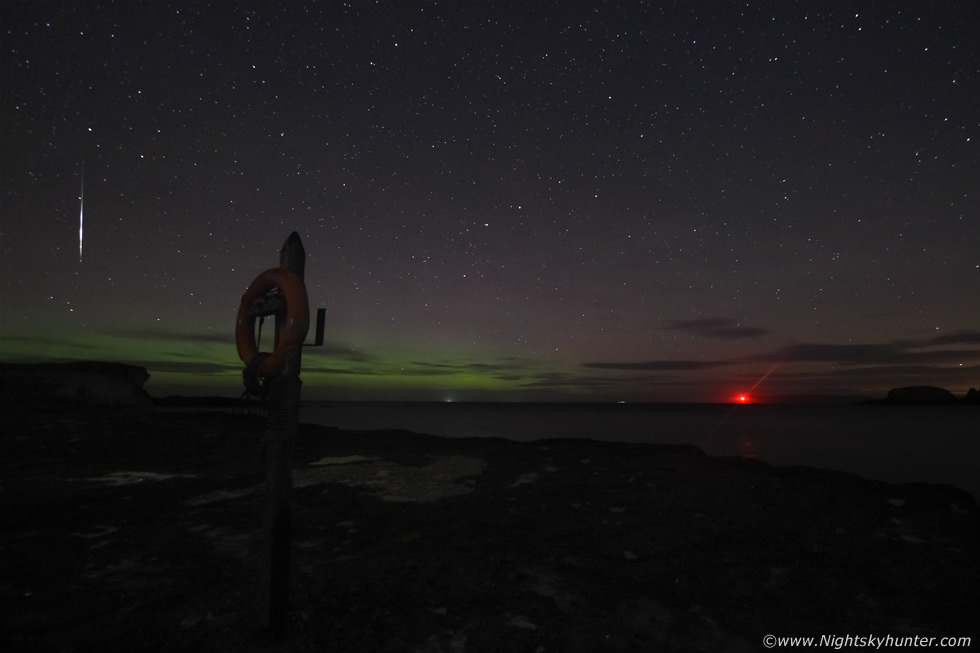 |
Glen headed away to a new location so Paul, John and I moved to an old favourite spot on lower ground at Ballintoy located on the east side of the harbour which involved a short hike across sand, rocks and rock pools, the location was tight to the ocean and away from other people which was part of its appeal so we could have peace to do photography without getting annoyed by lights. The view was good to the N and NE with Sheep Island standing boldly out among the stars. I set up the 600D at 10mm and began shooting a time lapse to the E of N with the composition focused upon this life buoy which offered nice foreground interest. I figured this one was going to be good because of the dark sky, stars, faint aurora and passing cloud which would greatly add to the final lapse. John had set up beside me then a second camera far behind us on the beach, both of these were also shooting time lapse. Paul was located to the left of my frame taking stills with his Canon 6D full frame, we were all busy and impressed by how dark the sky was and we all secretly hoped a Taurid fireball would enter our camera frames. Hunting meteors on camera is like fishing, you cast your net (camera lens) over a certain area of the sea (sky) and hope that sooner or later you catch a fish (meteor). My Samyang 10mm lens made for a great net, it boasted a huge FOV so I could cover a very large area of sky and it was F/2.8 which is considered a fast lens which collects more light which would greatly aid in capturing a Taurid. However reality is very different, meteors have a habit of appearing outside your frame and on other occasions they seem to stop appearing entirely, furthermore a meteor really does need to be bright to show up well on even a fast lens, this is because they move incredibly fast (Taurids at 28 times the speed of a bullet) so their light is fleeting and does not register as well on a camera's pixel range. John was also using the same lens and Paul was using another wide angle fast Samyang with a larger field and higher ISO, we all left our cameras to it, but we all agreed that we didn't want any 'fish', our standards were high for we could accept nothing else other than a wild Atlantic Salmon (fireball).
I spotted the elusive Gegenschein (counter glow) high in the E in Taurus within the region of sky between the Pleiades, Hyades and head of Cetus. The Gegenschein looked like an extremely diffuse large oval haze elongated along the plane of the ecliptic. Half an hour later I was blended well into the night and fully dark adapted, all three of us were quiet and lost in our own thoughts, I was casually looking to the N when suddenly a brilliant Taurid fireball blazed down into the northern sky at a steep angle, I shouted ''WOW, holy s**t!!'' - the fireball was silver-white in colour and so bright that it momentarily lit up the rocks and coastline where we stood and also reflected upon the ocean, the fireball left a glowing train briefly in its wake was located between the head of Draco and Hercules during its greatest brilliance. Wait, did I get that on camera?, I nervously approached the camera and worked out where it was pointing in relation to the stars and was disappointed that I hadn't, the fireball was too far N and would have been just outside the left hand side of the frame. However did anybody else?, Paul missed the visual sight but was shooting to the N and a quick check showed that he had captured it perfectly on camera, I have to say I was delighted for Paul, this was the best fireball we had seen in weeks and Paul had made a lot of sacrifice to be here this night - his main goal was to catch a fireball - and now he had it done it, this one capture had made the night. It was only towards the end of the shoot when I had a chance to preview my time lapse frames that I found out to my great delight that I too had caught it on camera!, above is the 10mm frame with the fireball to the left of the life buoy and not only that but I had it in the same frame as an aurora too, I was well pleased with this result and considered this shoot a roaring success. The image is dark because I was shooting 25 sec exposures for time lapse reasons however it is still a capture, I had cast my net and caught my Salmon and it would soon be on the pan (internet) the following morning. Keep in mind that this fireball was considerably brighter than how it appears on camera, you really needed to have been here to see it from this very dark location to do it justice.
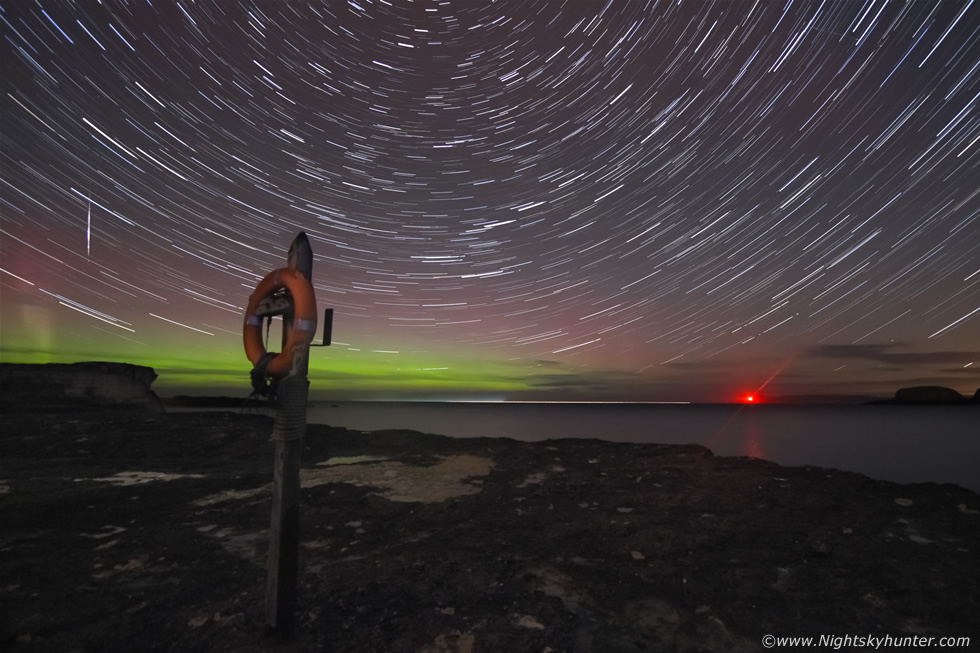 |
If this wasn't good enough the aurora went into a brief outburst around 01.00 UT producing a series of beautiful green and red rays to the N, annoyingly the best of these where out of my frame to the left but later new rays shot up within my frame either side of the buoy, I quickly set up my old 450D with 18mm kit lens and got a short time lapse of the aurora before the clouds closed in on us for good. The above image shows a star trail, aurora and fireball made from a small portion of the time lapse frames stacked together. Sheep Island is visible on the right hand side with the red light coming from a flashing light house located on Rathlin Island. Despite the cold we were all happy with the shoot, we got a well earned aurora, several fireballs, star trails and time lapse video so we packed up for the night. All three of us were now tired and starving with hunger so we stopped off at the 24hr McDonalds in Coleraine and feasted on chicken burgers, fries and coke, I also had a McFlury which helped sooth my dry throat from all the exposure to the cold night air, the atmosphere was good, we made jokes at the fact we were eating a McDs at 03.00 in the morning, no better way to end the night. I was back home just before 04.00 and Paul didn't make it home for another hour after that.
Five days later on November 11th I was out again on my first real storm chase of Autumn. A deep Atlantic low had produced an active cold front with heavy rain and strong winds the previous night and the post frontal sector looked extremely interesting with low to moderate CAPE over the W and NW ocean with cold air aloft in the -40 degree C range in a mild SWly flow with jet stream producing strong enough wind shear for tornadoes and even low topped supercells. John Fagan was already up at the north coast monitoring the convective situation however my original plan was to ignore the daytime stuff and head out as soon as it got dark for night time storms. However my plan was quickly changing for things were really kicking off during the early afternoon when a massive thunderstorm formed over the W coast of Donegal producing a lot of c-g lightning, radar showed the classic Eagle wing form typical of highly sheared storms like supercells. Although no hook was on radar this storm was big, organised, of long duration and sparking keenly, it was moving slowly over the ocean along the W coast and would soon appear to the NW and would be viewable from the N coast, I suspected that this cell could well have been producing funnels or even a waterspout, I immediately regretted not leaving early to gets eyes on it and due to its motion I knew it would be too far away by the time I got there. John sent me a message saying he was watching that area however the cell was mostly obscured by low grey cloud so visibility was bad and hence no chance of seeing funnels or storm structure. This storm had got my attention and soon the radar was showing new cells forming in it's wake out to the W and SW moving NE so I hesitated no longer and hit the road. I arrived at Downhill beach on the north coast by mid afternoon and parked on the sand, there was no sign of John yet, he said he would meet me here soon.
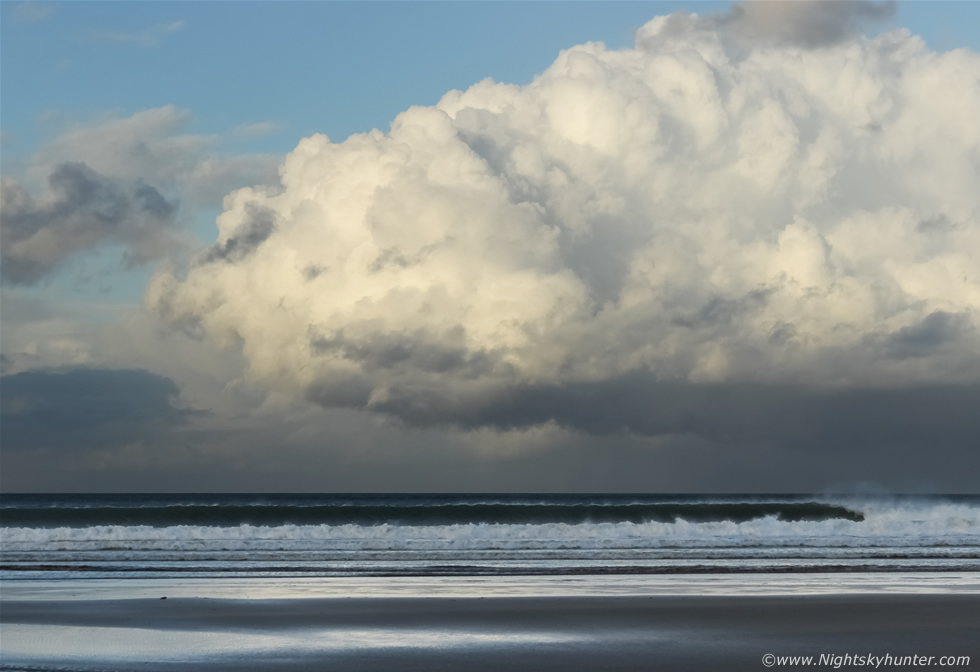 |
My timing was good for a new storm cell had formed over the sea catching the bright sunlight with cloud tops sporting a bright cream colour against the clear blue sky. The cell was a fair distance out over the ocean to the N moving L to R and away from me and despite being low topped it looked great with multiple updraughts bubbling up due to the unstable cold air over a warm moist ocean, I snapped this one with the kit lens showing the flanking area of the cell. Note the rain free base and precip core to the far L which extended a good distance outside the frame, it was my belief from observing the cell that those updraughts were very well sheared and may have had slow rotation. I set my 'work horse' Samsung video camera on the beach with its mini tripod legs stuck into the sand, zoomed in, and began recording video for a time lapse. Upon arrival my attention was stolen by the cell so I neglected to check the van, I had forgotten that both side windows were down so sudden squalls of wind blew sand straight through one window and out the other, the inside of the dash and seat was covered in grains of sand.
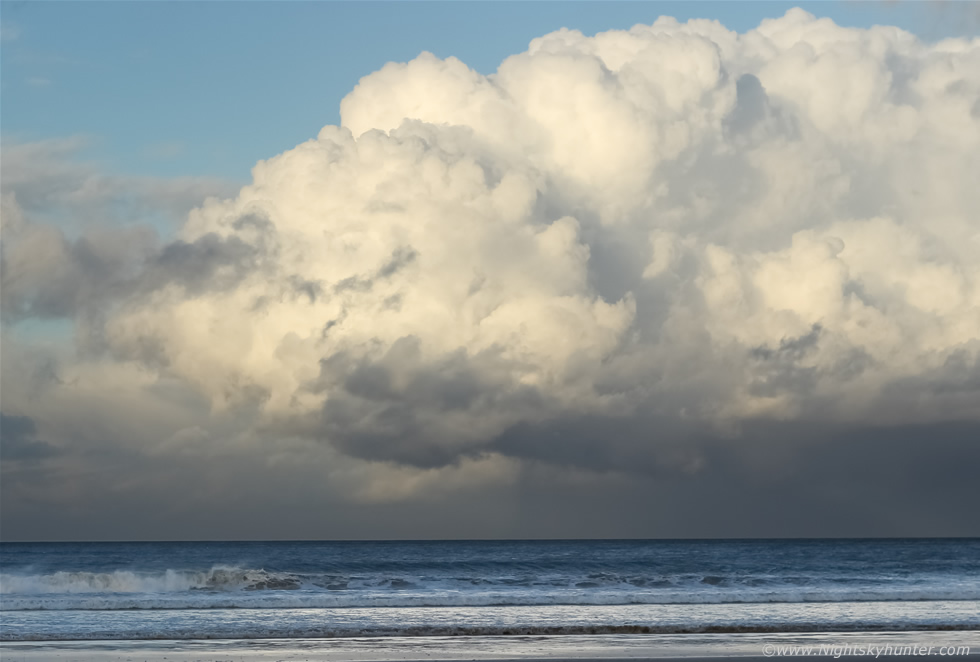 |
50mm F/1.8 lens with back building updraughts, the cell looked nice in the afternoon light over the ocean which was sending small but fast moving breakers on shore. I watched the base carefully for funnel clouds and waterspouts, I had my 100-400mm telephoto lens at the ready just in case. The clouds in the background below the base belong to the Donegal storm I had been watching on radar earlier and which was now miles away out to sea.
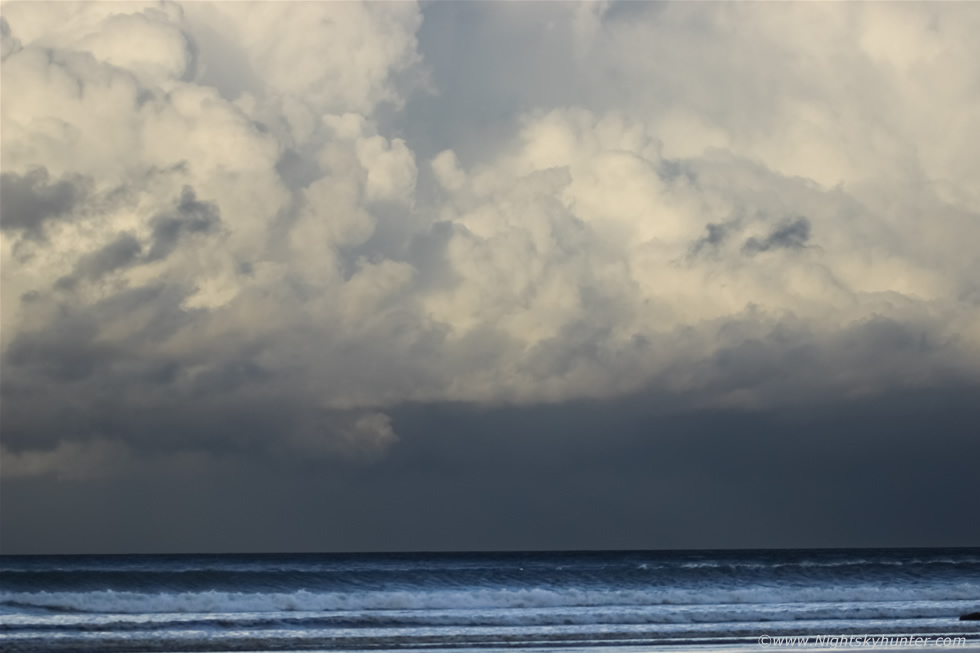 |
200mm into the base, I can tell you that after the poorest Spring and Summer of storms I have ever seen in this country and the uneventful grey high pressure start to Autumn I was extremely grateful to be seeing this, any convection was a blessing so I made the most of it, eventually the storm drifted far away towards the W coast of Scotland so I let it go. In the meantime there were strong gusts of wind blasting across the beach lifting the sand and blowing it at high speed in the form of swirls and streamers which looked very cool so I picked up my video camera and began filming, the squall was hitting from behind and I could feel the wind cutting through my back penetrating my insides, it was unpleasant to stand in however the visual sight in front of me was great. When I pressed stop I looked behind me and there was John watching in his van parked beside my own, he said he didn't want to interrupt me while I was filming so fair play to him. We got talking about the cell and it turned out that John had been shooting it too from Portstewart and got fine images over good foreground for a sense of scale, we hoped we would get more of the same when darkness fell.
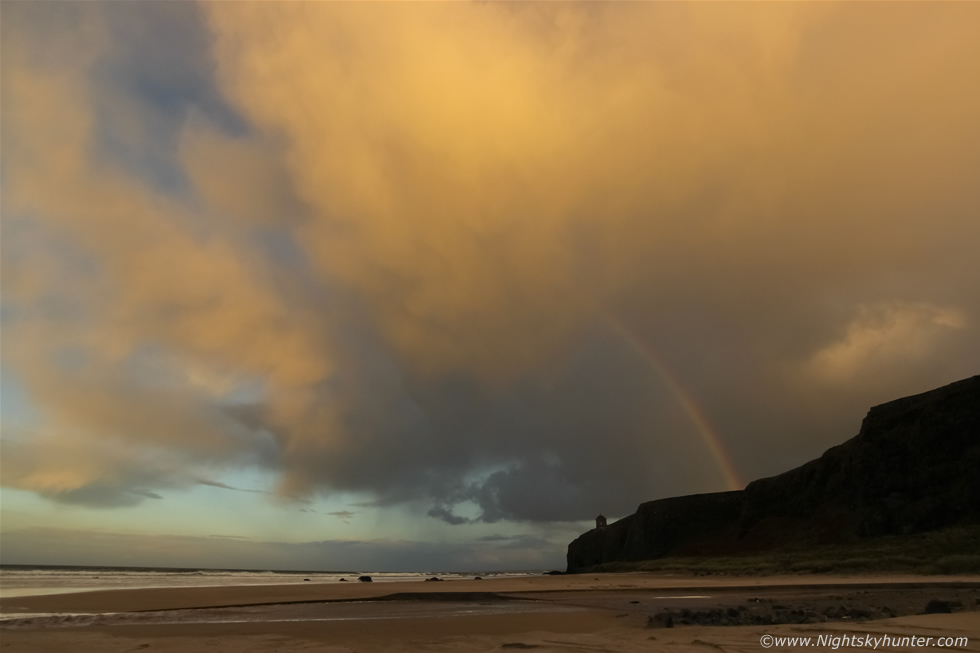 |
We stayed on Downhill beach until sunset and got treated to a nice set of primary and secondary sunset rainbows - sunset rainbows differ from normal rainbows by having a more pronounced red colour which is often striking on the outer edge. A shower with a small orphan anvil drifted over sporting subtle mammatus which got lit into fantastic gold and yellow colours by the last light of the setting sun. At dusk we were beginning to get cold feet, the sky was 100% clear and we couldn't see a cloud or anything remotely convective out W, we had to be patient and had some time to kill so during astronomical darkness we drove into Castlerock and got coffee and snacks at the local filling station then returned back to the beach and ate our snacks there, I even had a packet of popcorn which I enjoyed munching on while watching the sky. Some time later clouds appeared to the W and NW with towers then suddenly John spotted a flash of lightning to the NW, later there was another and we realised that things were happening and growing fast, there was obviously a cluster of single cell storms far out over the sea slowly moving up on the SWly flow so we decided to change location and get a better view. We drove eastward around the coast and while in transit we saw more lightning flash over the sea, we stopped at Dunluce Castle and saw another to the NW, we were tempted to begin shooting from here but an annoying security light was beaming across the car park and into the air across our FOV, it seemed to be coming from one of the houses beside the car park, there was no way we could shoot from there so we got back in the vans and continued driving.
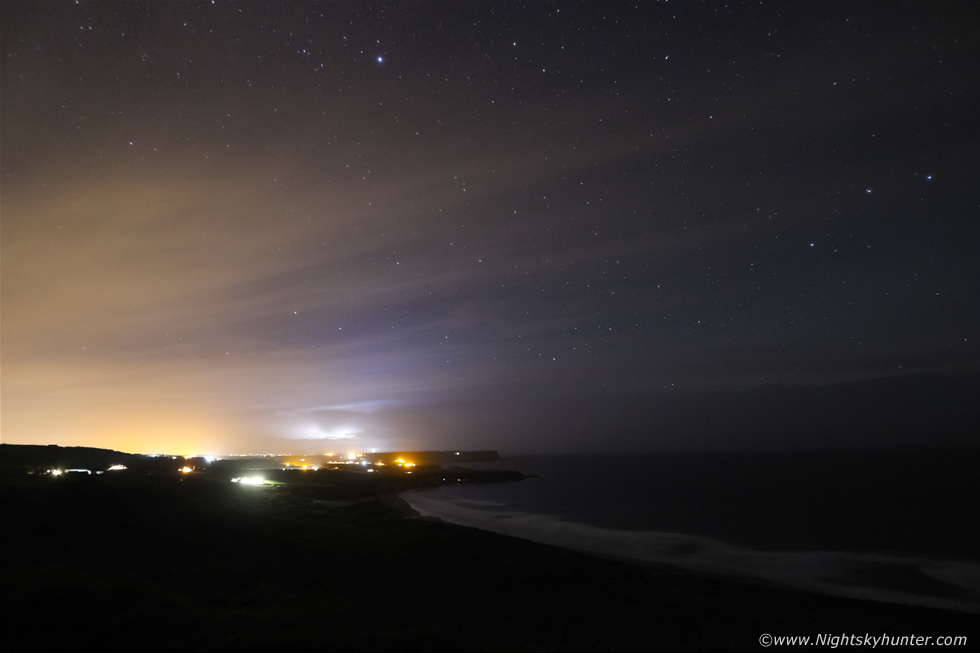 |
We found a perfect vantage point in the lay by above White Park Bay beach, it was cold and windy so we set up our cameras using the vans for shelter and began shooting. Lightning again, this time out west, I began patrolling at 10mm and FLASH - I got it on the wide angle lens. You can see the cell lit up over W. Donegal and if you look carefully you can also see a c-g lightning bolt, the cell was moving L to R so I knew I had a few more chances so I switched to the 50mm F/1.8 lens then John was set up beside me shooting too.
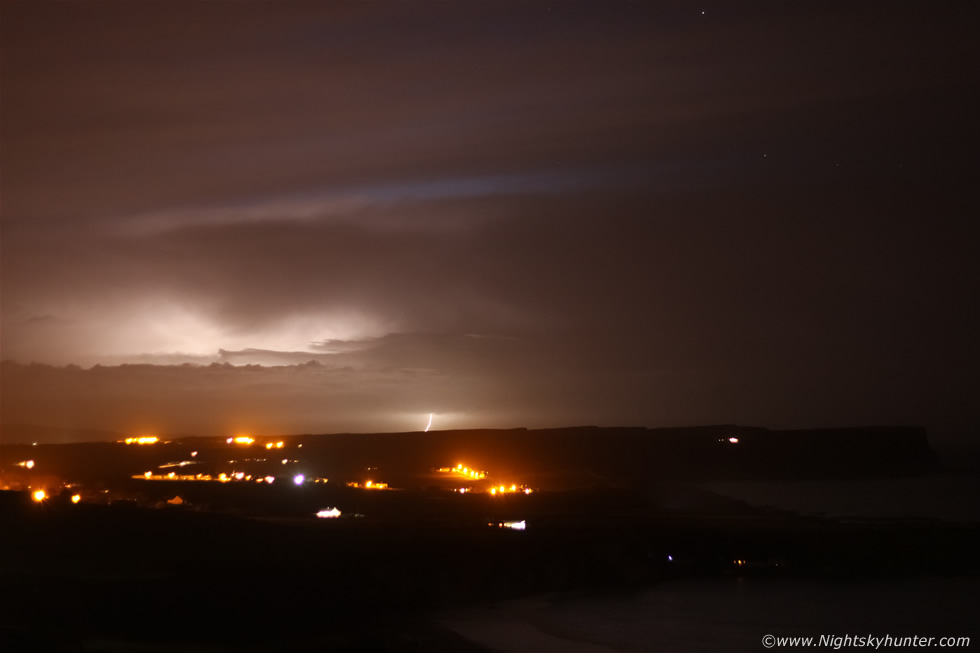 |
Luck was on our side, or maybe it was relentless dedication, whatever the reason we had an active cell then on the next flash I captured the lightning in the 50mm frame with another clear c-g, radar later showed that these were striking over ground in Donegal and not over the sea.
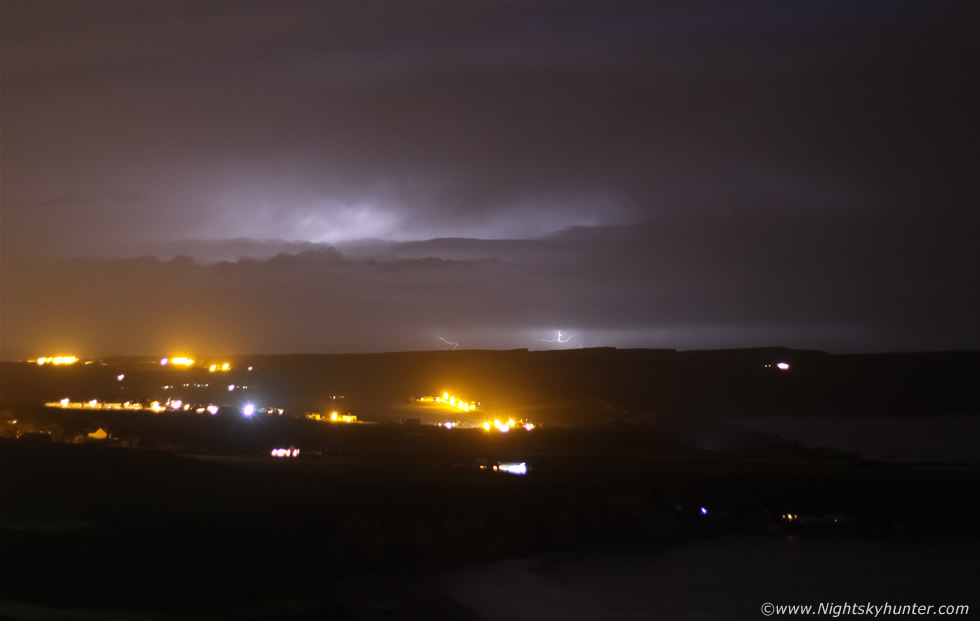 |
Another capture, this time using tungsten white balance with twin i-c bolts or possible c-gs behind the cliff tops. At this point we were in heaven and we soon had identified five different storms which were periodically flashing, one to the N and NW, two out W and one to the SW, they were all far away however we could still see the lightning flashes and the occasional distant c-g, because it was a dark moonless night these cells were like stealth bombers, we couldn't see them approach over the dark ocean until the lightning started so it was quite exciting watching the action. It really was a shame they where so distant however a storm is a storm so we were happy enough and in our element. We concentrated our cameras on the closer Donegal cell, using the distant lights we knew its exact position and began shooting in that direction as it got closer as we anticipated the perfect c-g shot we were going to get, but nothing happened at all, it was like a switch had been flicked and all the sparks had stopped, we couldn't believe it, just when the storm was close and lining up nicely for a great shot, our conclusion was that the wind shear was weakening so these were likely single cell pulse storms and hence had short life cycles. Still all being said and done it was a nice visual show while it lasted and we managed to capture several of these distant storms on camera which was a great thrill. This cell knocked out the power supply in parts of Donegal with lightning even striking a house.
We had stopped shooting however John and I just stood their in silence feeling content yet on alert for more as we peered across the dark ocean while admiring the stars, occasionally an orange Taurid streaked through the sky grabbing our attention. Suddenly a car pulled up behind us, inside was an elderly man and women, they were obviously intrigued by what we were doing and began asking questions, however within seconds we were getting agitated and frustrated by their intrusive presence. We couldn't tell if they had been drinking or just plain silly, they asked us all sorts of questions and were extremely nosey, are these our vans?,where we lived?, how many miles away was that?, then they started talking about seeing UFOs from the very spot we where standing, a plane passed over and the women said that was one of them, she didn't believe us when we said it was a plane, I mean it was very obvious, it certainly wasn't a real UFO by any means, now we were getting pi**ed off because this lady was either not all there or just taking the hand out of us, we had had enough, made our excuses and left.
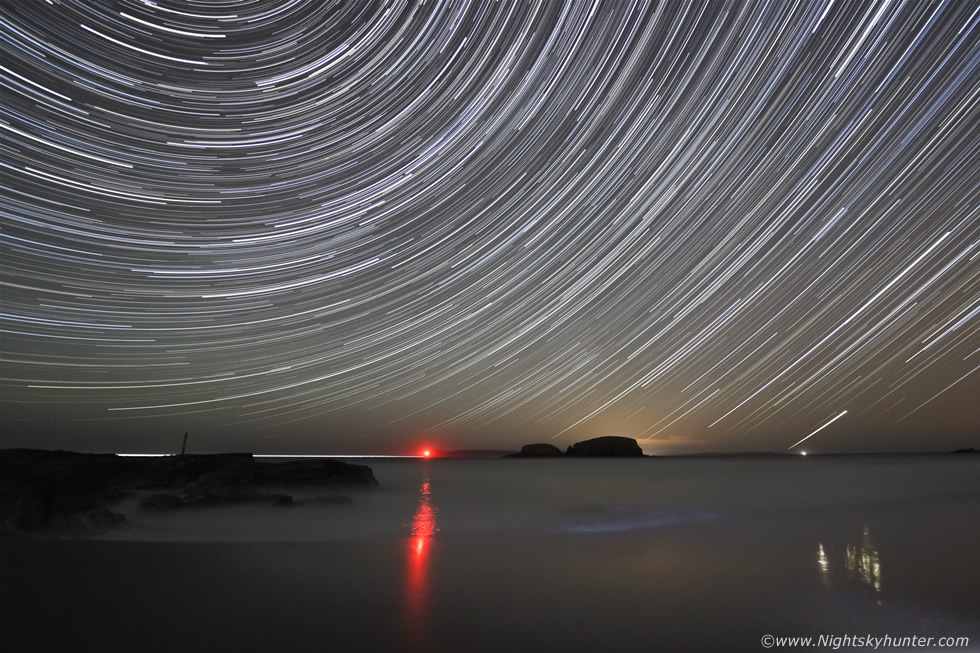 |
We parked at Ballintoy harbour fairly late in the night and bumped into another photographer called Mark McMullan, the three of us had a good chat about storms sharing our thunderstorm experiences from past years which was very enjoyable, but well into the conversation we kept seeing bright blue flashes of lightning far away in the direction of Scotland, we couldn't see the cells just the flashes so we speculated that the cells could have been 100 miles away or more then it dawned on us that we should have been shooting in that direction just in case we captured a very rare sprite. We cut the conversation short and all three of us walked down to the quiet section of coastline near the life buoy, set up our cameras, and began a 10mm time lapse looking across the sea towards Sheep Island in the direction of the lightning. The lightning stopped when we got set up so we just shot away anyway as we enjoyed the clear dark sky for several hours. This is a star trail from that shoot, the red is from a lighthouse on Rathlin Island and the beams of light to the lower right are actually the multiple glitter paths of planet Venus who's trail can be seen rising above the distant white light. We had a good chat about astronomy and cameras, the old DSLR vs mirrorless camera conversation got a good covering and yet again we spotted the Gegenschein, it was a cold night, fairly calm at this stage however standing on the cold sand and rocks severely zapped our warmth and by the end of the patrol we were glad to get packed up and back in the vans for some well deserved heat.
The following night, November 12th, looked to be even more epic. The ocean CAPE was higher and wide spread all around the country and the models showed good precip rates from cells over the NW and N coast so things looked very good indeed, John and I were game for another late night. The Met Office had warnings out for 60mph winds at the coast with stronger gusts and for a while I contemplated not going as setting up a camera for exposures in such conditions rarely worked out, I had tried it many times before but often the tripod blew over, however being an optimist I was up for it anyway and so was John, we discussed a few places which could offer us protection from the Wly gales and soon a plan was formed. Inside my head alarm bells were going off, when I looked at the higher resolution models they all looked great however I did notice a fair amount of CIN - Convective Inhibition - over the W and NW coast, CIN is similar to a capping inversion which would stop the vertical growth of storm clouds. I just assumed the CIN wasn't of much concern with -40 C air aloft and besides ESTOFEX already had a thunderstorm forecast out with a level 1 and TORRO had issued a Tornado Watch with a risk of storms with c-gs, moderate size hail and severe wind gusts, so I didn't think any further about the CIN and hit the road when darkness fell.
I met up with John at the Antrim coast under clear skies and together we checked out new areas of the coastline for future shooting which involved a good bit of walking and plenty of back and fourth driving. We spotted a green aurora in the N, there was supposed to be G1 potential this night however it looked like a damp squib with just a diffuse glow of low surface brightness. We stopped for a while at Portbradden and shot a star trail and time lapse there, we did see quite a few flashes from cells near Scotland, these where embedded within the ana cold front which had crossed Ireland earlier in the day however there was no sign yet of the post frontal action we had been hoping for. After a lot of test shooting, scouting and waiting we changed location in preparation for the late night ocean thunderstorms which were expected to kick off between midnight and 03.00 UT. We parked in the White Park Bay lay by again, vans side to side and watched and waited. We spent hours here, the gales never came near 60mph, in fact, the wind had been stronger on the previous night, however it was still cold and from time to time the vans rocked in the stronger gusts. We waited for hours and hours, used up our food supplies and drained the flasks and not a single flash to be seen, in fact, it barely even rained once and we never saw a single convective or vertical cloud the entire time, the police event checked us out to see what we were doing, the local clouds were like a flat blanket and it dawned on us that this had been a damp squib, then suddenly it hit me, this was the result of the CIN on the charts, the atmosphere had been strongly capped so we called it a night and made it home for near 05.00 empty handed. I only include this part because its good for people to know the reality of this kind of photography, 99% of the time you read about the success but rarely do you read about the failures, this was one such failure however it is all part of storm chasing and elemental photography, you learn to take it on the chin and try to learn something from the event and still maintain a positive attitude, after all, if it were easy it wouldn't interest us, storms are extremely challenging and that is why we didn't see any other photographers out on this stormy night at all.
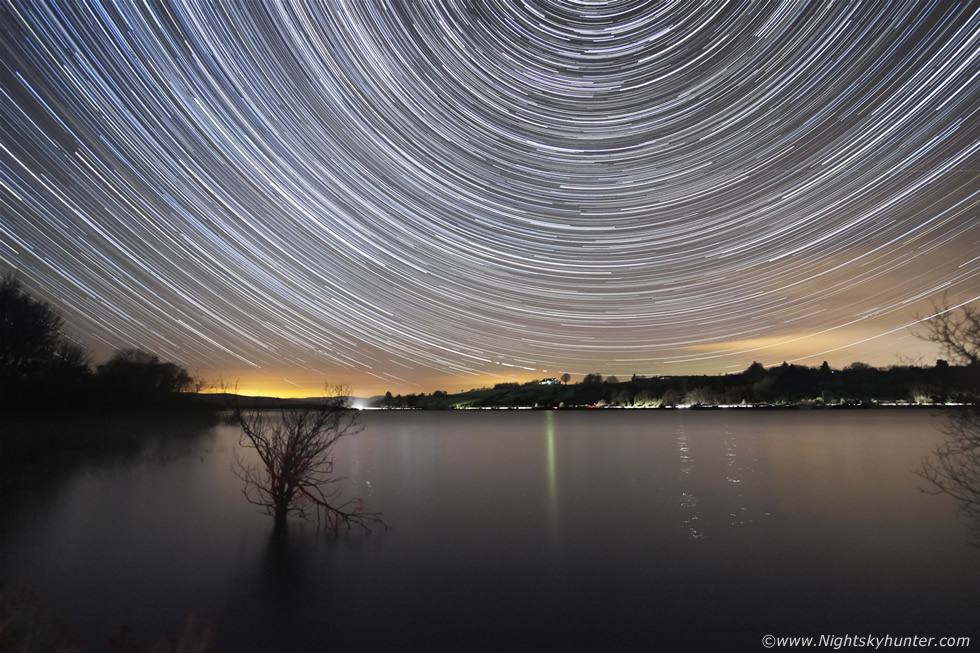 |
November 19th turned into an unexpected shoot, the sky was clear however I wasn't planning on doing any photography at all. During the late evening that changed when suddenly the aurora began to stir to minor storm levels from a fast solar wind stream hit, the Bz dropped very far S and was sufficiently tilted in the negative to get my attention, however I was still not convinced and was unsure what to do. I got a message from John Fagan who was in Dungannon and up for shooting the aurora and soon John had talked me into going too but instead of the coast we decided to meet local and shoot from an inland location, we chose Lough Fea in Co. Tyrone. I was getting married on November 27th in only eight days time so I decided that this would be my last photo shoot because I wanted to be in good shape for the wedding so I needed rest and recuperation for the big day. I met John at Lough Fea and together we walked around the shore until we found a suitable spot,a few test shoots showed an aurora with red colours to the N and NW and soon I spotted two very faint rays with the naked eye, we set up the cameras at 10mm and began a time lapse across the lake but soon the aurora had faded away to a glow then vanished completely. However the night sky was absolutely stunning, the Gegenschein was very clear, even more so than when we observed it at the coast. The Leonid meteor shower had peaked just two nights earlier and the shower was still active so we decided to let the cameras continue shooting their time lapse to the N just incase. Behind the Winter sky was breathtaking, Orion and Sirirus looked sublime and my instincts told me to set up my other camera and time lapse Orion transiting across the meridian, however the camera was back in the van and feeling cold, tired, a quite burned out from all the recent shoots I decided to let it go.
That decision would prove to be a big mistake, I should have trusted my instincts. John and I were facing N across the lough with our backs to Orion when suddenly the entire sky lit up from somewhere behind us, the sky, trees and lake lit up like daylight for a second then everything was plunged back into darkness. I immediately shouted 'lightning!!!!'', because I thought it had to be lightning to have produced so much light, we turned around to the E and instantly it struck us that it wasn't lightning at all, this was celestial in nature and a product of our violent and dynamic solar system. Between Orion and Lepus was a straight glowing orange train over 20 degrees long (40 full moon diameters) sitting among the stars, we knew straight away that we had just seen a Leonid fireball and that this was the train it left behind. I immediately took out my phone and activated the voice recorder because sound can often accompany major fireballs like this. We didn't hear anything however the long train faded away and in its place a vivid orange coloured smoke train appeared below Orion and with the naked eye in real time we watched it change shape among the stars as high altitude winds distorted its form, at one point it looked like an orange bar with two comet tails then it took on the shape of the letter 'Z'.
This was an incredible sight, the parent fireball must have been brighter than a full moon in the mag -15 range. Once the smoke train faded we walked back to the vans, got the other cameras, returned, and set up a new time lapse in that area of Orion incase it happened a second time, it never did, but amazingly when I played back the time lapse the camera had detected the smoke train now far below Orion, it was still there and could be seen expanding like a shell on the images, we worked out that this smoke train must have been visible for over 25 min's!!!. The annoying thing is that had I trusted my instincts and set up the 450D at the very start of the session facing Orion then I would have caught that fireball on camera with a full time lapse of that amazing smoke train, it would have been my best astronomical image ever. We will never forget this night, we indirectly saw it light up the landscape in spectacular fashion, it was very similar to the Leonid fireball which myself, Conor McDonald and John McConnell observed back in 2009 which also left a stunning smoke train among the stars, the two events were only six years apart however they felt like a life time. Thanks John for talking me into going out this night for had I stayed in I would have missed this incredible spectacle, and even though I missed it on camera it gave me all the motivation I needed to try again for another fireball event during future Leonid showers.
Time lapse video of the off-shore cell from Downhill beach, the blowing sand in the squall and time lapse from earlier that same day of a clearing cell with nice back sheared anvil captured from Maghera at it quickly moved E. Not long after this the squall line the anvils were associated with damaged property in Co. Antrim, the event was reported in the media as a tornado however there has been no supporting evidence yet, however it was still severe and more than likely was caused by straight line winds from the line.
Time lapse of the stars and faint aurora display from Ballintoy Church then aurora outburst time lapse from the harbour captured with the life buoy in the frame.
Time lapse of stars and fading aurora over Lough Fea followed by another time lapse of Orion with expanding smoke train from the mag -15 Leonid fireball which lit up the sky some 25 min's earlier. All of these videoes are best watched at 1080p HD. Thanks very much for reading.
Martin McKenna